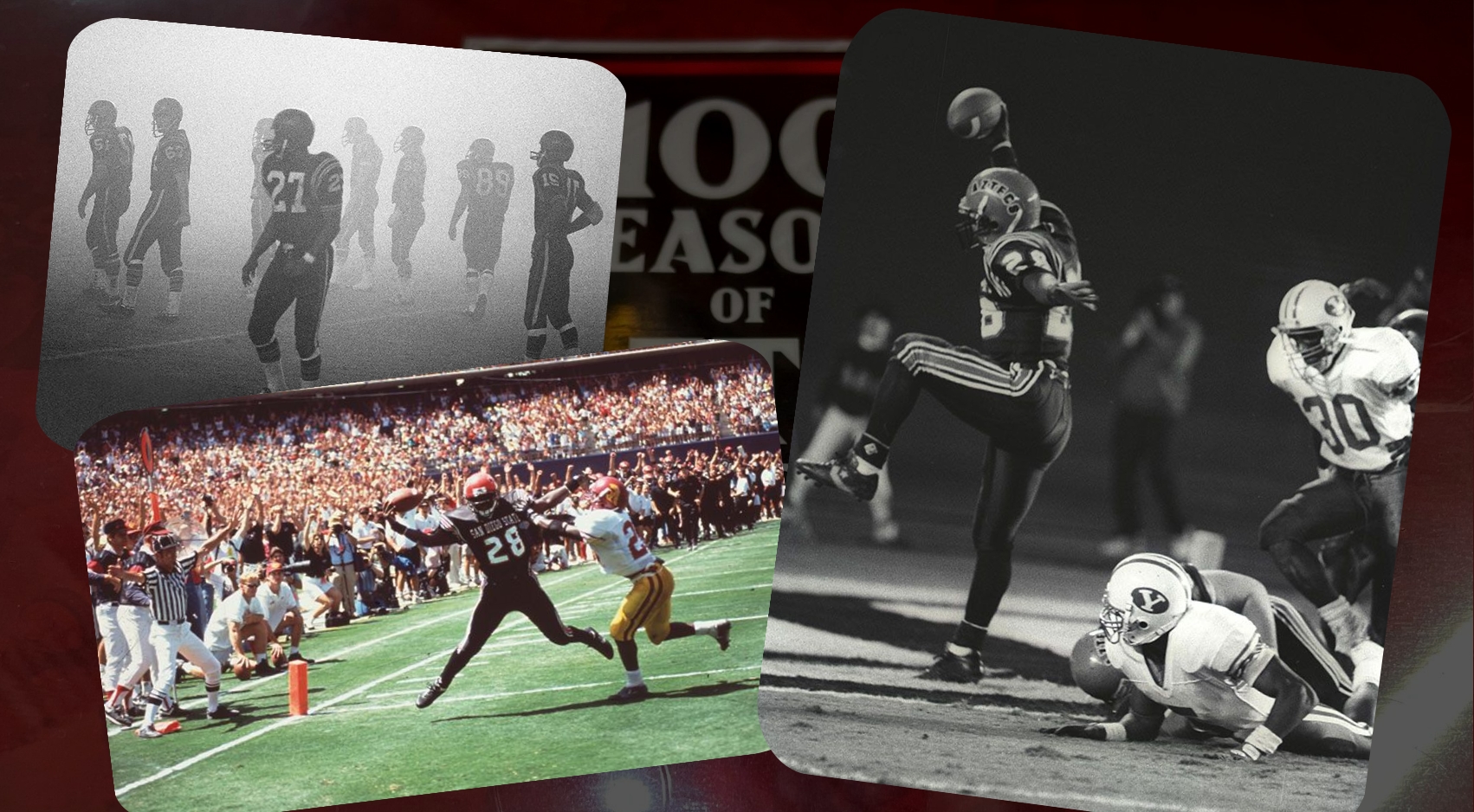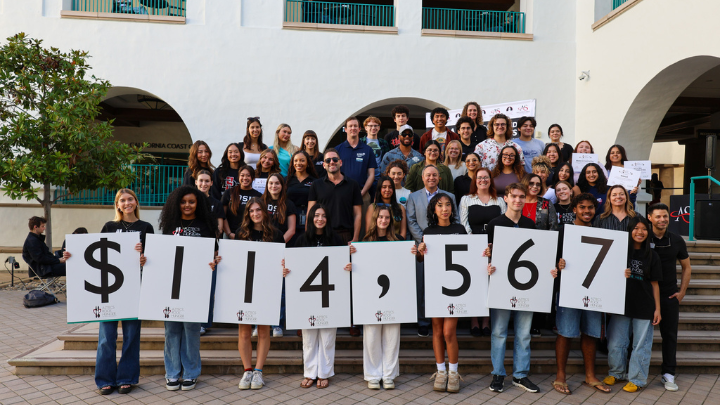Between the Covers: 100 Years of Aztec Football
History Curator Seth Mallios has written a 489-page book tracing the universitys football program from the days when there were barely enough men to field a team.

It weighs in at 7½ pounds, just a half-pound less than the birth weight of his first child, Gabby.
San Diego State University History Curator Seth Mallios completed the 490-page “100 Seasons of Aztec Football” (2022, Montezuma Publishing, $129) just before the ’22 season got underway at Snapdragon Stadium in SDSU Mission Valley. Also the author of the SDSU archaeological history book “Hail Montezuma!,” Mallios will be signing the new book at 11:30 a.m. Saturday, Feb. 11, near door 4 of Viejas Arena prior to the SDSU/UNLV basketball game.
Intercollegiate seasons began in 1921, when the San Diego State Teachers College team played under head coach Charles Peterson, namesake of the campus gymnasium. Its first game, a 6-0 win over Army-Navy Academy, was followed by three consecutive losses. Mallios’ book stretches back even farther, however, documenting club seasons held off and on between 1901 and 1905, when men were a small fraction of the student population at the San Diego Normal School for prospective teachers.
In a year-by-year march through history, Mallios chronicles numerous “firsts” including the crimson and black uniforms (1928), night game (1930), as well as the last stalemate (1992, 31-31 vs. USC).
SDSU NewsCenter spoke to Mallios Tuesday about the history he uncovered and key moments in Aztec football history. (Interview edited for length and clarity.)
We’re about to get word of Don Coryell’s possible induction into the Pro Football Hall of Fame (Update: Coryell was selected for induction on February 9). At San Diego State he was the most successful coach of all time. But what were the expectations when he was hired?
They couldn't have been lower. We had just gotten blown out in homecoming against our archrival (Fresno State), lost 60 to nothing at Aztec Bowl, a true low point for the team. And that's why the college took a risk on this 37-year-old that very few people had heard of. He was coaching the running backs at USC and he had had a couple of head jobs at much smaller schools in the Northwest. But Don Coryell was not a household name, and it was a total surprise.
I think of it as that moment when you hit rock bottom, you're willing to take some chances to turn things around.
In addition to the three national championships, what would you say is Coryell’s legacy at the college level?
I think it was the factor of his coaching tree and all the individuals that he influenced — John Madden, Joe Gibbs. We put together this great family tree coaching tree for Snapdragon Stadium that shows these individuals. It goes all the way through more modern coaches with Norv Turner, Gunther Cunningham, to look at his influence on people.
That gets folded in with how he changed the game of football at all levels in terms of the passing game, in terms of putting players in motion, in terms of using the tight end. Every NFL team’s playbook right now is full of Don Coryell’s plays and that's why it’s a no-brainer that he should be in the NFL Hall of Fame.
Your book mentions coverage in the local newspapers going back to 1900, literally the very first days. Has San Diego felt like the football team was part of the city this whole time?
Yeah, I think one of the interesting things is in other cities there's all this competition for identity with an institution, and in a lot of places the term “State” is derogatory. Not here. We were first, and the name State has always been in our name, whether we were the State Normal School or San Diego State Teachers College, or San Diego State College, or San Diego State University.
The town really grew with this institution, and in other histories that I've written we talk about the false starts of higher education in San Diego; San Diego State was the one that stuck. And so there is this close identification, and that builds with the success of the sporting teams, and also with some of the downtimes, too. It weeds out the fair-weather fans but it makes the true fans appreciate the good times even more.
There’s an anecdote about Carl Weathers (an Aztecs linebacker for two seasons) possibly coining the phrase “Aztec for Life” during a TV interview. What a fascinating part of San Diego State history that is.
The thing I love about Carl Weathers, too, is when you hear him speak, the message he puts forth is hard work, grit, and determination. He doesn't talk about natural talent. His message is, if you want to be an actor, go act. Don’t try to be a movie star out of the gate. Work in local theater.
You see that in terms of his football career at San Diego State. He just becomes part of this team. It's worth emphasizing: he never lost a game at San Diego State. He played in ‘68 and ‘69. This was the time where the school jumped from that (NCAA) College Division to the University Division, today’s Division I. Everyone is sure that they're just gonna get clobbered and they go undefeated.
That’s one of the themes that comes out in going through the book: the Aztecs exceeding expectations.
Yeah, I think one of the crazy things about writing this book is I knew how each season turned out in advance and yet I was still on this emotional roller coaster. Even when I knew they were going to lose a couple of games, the agony of losing those games and then regrouping.
I make a big deal about the team in ‘66, because that was the first perfect season, and they had come so close in the two years before it. So I think that there is this theme of exceeding expectations, but there's also a dramatic build-up when we do finally beat a rival. Nothing feels cheap about San Diego State victories in football. They are hard-earned.
At the risk of asking you to pick a favorite child, is there any single game out of more than 1,050 in 100 years that really stands out?
There’s a game against Fresno State in 1950, where the team is down by a touchdown with one minute to go, and they had just coughed up the lead. The team was devastated, and they really have time for one play left. And the ball gets thrown to Art Preston, his nickname was Presto, and he broke the tackle of all 11 Fresno State defenders and wove all the way through the defense for the winning score. The papers at the time talk about how you could hear the cheers all over the city of San Diego.
(In) 1966 North Dakota State was the defending national champion. They come to San Diego, and not only does San Diego State win, they shut them out 36 to 0. The largest crowd ever at Balboa Stadium.
For me personally, I was at the game against Stanford in September of 2017. Stanford was ranked 19th. We're losing. Things look terrible. The power goes out; it’s out for 22 minutes. It was one of the most bizarre scenes I've ever seen. Everyone's holding up their cell phone, it takes the light so long to reboot.
All momentum is lost, and then there's a last minute touchdown pass from Christian Chapman to David Wells to win it all. So I think, for me, personally, that was my favorite. But there are a few others that really stick out for the alumni.
(Updated Feb. 9, 2023, to reflect selections for the 2023 Pro Football Hall of Fame.)



